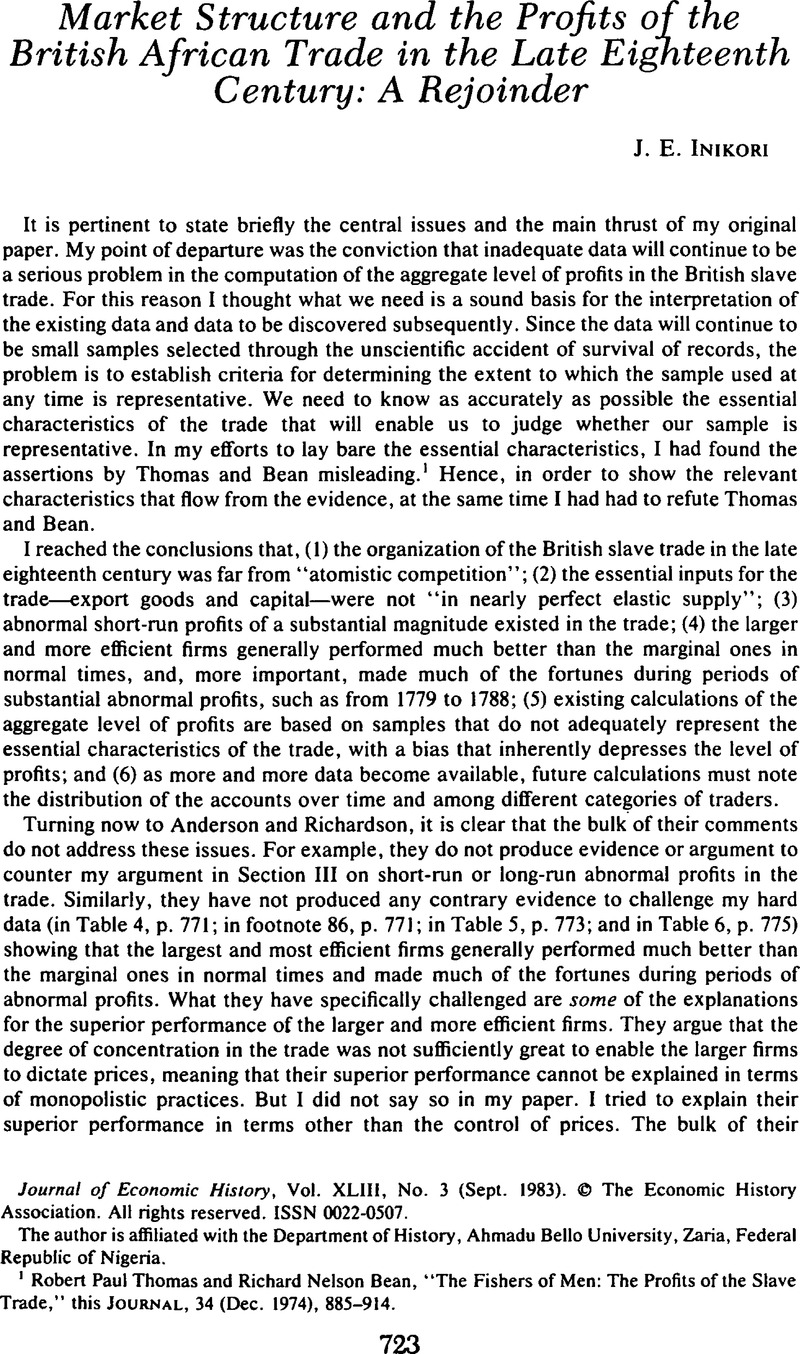Published online by Cambridge University Press: 03 March 2009

1 Thomas, Robert Paul and Bean, Richard Nelson, “The Fishers of Men: The Profits of the Slave Trade,” this JOURNAL, 34 (12. 1974), 885–914.Google Scholar
2 For the accounts of the fortuitous access to a large amount of capital resources by John Dawson, William Boates, and Thomas Leyland, see Hughes, John, Liverpool Banks and Bankers, 1760–1787: A History of the circumstances which gave rise to the industry, and the men who founded and developed it (Liverpool, 1906), pp. 169–73;Google ScholarStewart-Brown, R., Liverpool Ships in the Eighteenth Century, Including the King's Ships Built there with Notes on the Principal Shipwrights (London, 1932), pp. 126–27;Google ScholarWilliams, Gomer, History of the Liverpool Privateers and Letters of Marque with an account of the Liverpool Slave Trade (London, 1897);Google ScholarMackenzie-Grieve, Averil, The Last Years of the English Slave Trade, Liverpool 1750–1807 (London, 1941).Google Scholar
3 Wallace, James, A General and Descriptive History of the Ancient and Present State of the Town of Liverpool (Liverpool, 1795). Table I of my original paper was constructed from information provided by Wallace in this book.Google Scholar
4 Ibid., pp. 230, 249–50.
5 Inikori, J. E., “Market Structure and the Profits of the British African Trade in the Late Eighteenth Century,” this JOURNAL, 41 (12. 1981), 753–57. The letters quoted are just illustrations from a large body of similar evidence.Google Scholar
6 Inikori, J. E., “West African Import and Export Trade, 1750–1807: Volume and Structure,” in Essays in Honour of Professor K. O. Dike, ed. Ikime, Obaro (Ibadan, forthcoming), where this is computed on the basis of data from Customs 3 and 17.Google Scholar
7 Farmer, James to Galton, Samuel, Rouen, , 3 01 1749, Galton Papers, Galt. 408/4. Birmingham Reference Library. My italics. Apart from the poor reputation of British goods in West Africa at this time, the whole of British African trade was at this time undergoing a total reorganization from a monopoly company (the Royal African Company) to a regulated company (the Company of Merchants Trading to Africa). Besides, the firm of Farmer & Galton was still very young.Google Scholar
8 Galton Papers, Galt. 548: document showing the state of Farmer & Galton's gun business. The document is not dated, but internal evidence shows that is was an inventory drawn up in the mid1770s. My italics.
9 Galton, Samuel to Farmer, James, 19 05 1752, Galton Papers, Galt. 408/13. Which of the two was the actual writer of the letter is not very clear. Although Samuel Galton was more likely (from the internal evidence), it is also possible that is was written by James Farmer. My italics.Google Scholar
10 Galton Papers, Galt. 548. This document shows that of the firm's total circulating capital of £39,882: l:5d, debts by the firm's customers amounted to £22,228:6:7d. Farmer and Galton lamented: “out of about £22,000 outstanding debts due to us at the taking the last inventory 1772 March 31st there now remains near £9,000 unpaid, which from the distress attending people in Trade we were and are now obliged to submit to unless we proceed to obtain paymt by rigorous means.”
11 Public Record Office, C. 109/401: The accounts of the slave-trading ventures made by Samuel Sandys & Co. of Liverpool in 1771 show that Thomas Falkner of Liverpool, Farmer & Galton, Joseph Adams and John Parr all supplied guns and allowed 17 1/2 percent discount for cash payment.
12 If an individual in Bath had £1,000 (borrowed or personal) to invest and decided to put it into some Bristol slaving ventures, whatever he got at the end of the ventures would be regarded by him as a return on his £1,000, without taking the credit purchases by the venture managers as part of his investment. It is on this basis that he would judge whether his £1,000 would have yielded higher returns in an alternative investment or not. This is simply logical and requires no supporting evidence.
13 In footnote 86 I produced evidence from Davenport's ventures showing clearly that ventures landing 300 slaves and more were consistently more profitable than other ventures. Compared with other landings in the New World, the average for the Davenport ventures was 18.4 percent lower than the general average, meaning that Davenport's landings were substantially lower in size than those of the more prosperous firms. All that Anderson and Richardson have done is to explain why Davenport's landings were small per venture, which does nothing to the main point. Their point about Davenport's inability to gain direct access to the markets in the non-British colonies in the New World follows the same pattern.